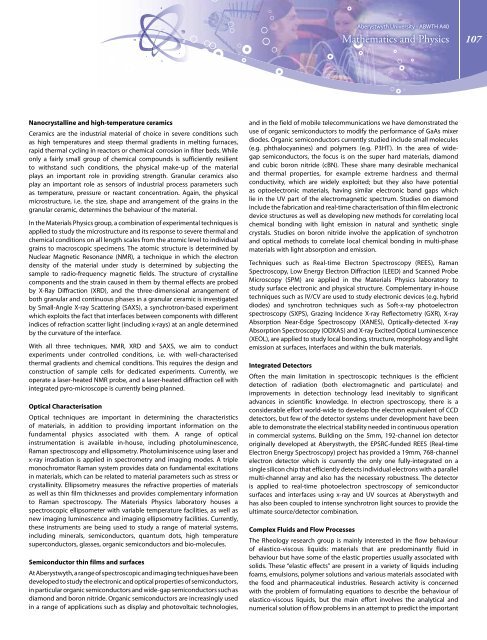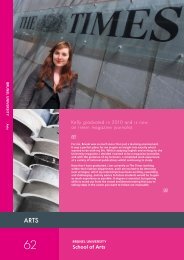Postgraduate Prospectus 2011
Postgraduate Prospectus 2011
Postgraduate Prospectus 2011
- No tags were found...
You also want an ePaper? Increase the reach of your titles
YUMPU automatically turns print PDFs into web optimized ePapers that Google loves.
Aberystwyth University - ABWTH A40Mathematics and Physics 107Nanocrystalline and high-temperature ceramicsCeramics are the industrial material of choice in severe conditions suchas high temperatures and steep thermal gradients in melting furnaces,rapid thermal cycling in reactors or chemical corrosion in filter beds. Whileonly a fairly small group of chemical compounds is sufficiently resilientto withstand such conditions, the physical make-up of the materialplays an important role in providing strength. Granular ceramics alsoplay an important role as sensors of industrial process parameters suchas temperature, pressure or reactant concentration. Again, the physicalmicrostructure, i.e. the size, shape and arrangement of the grains in thegranular ceramic, determines the behaviour of the material.In the Materials Physics group, a combination of experimental techniques isapplied to study the microstructure and its response to severe thermal andchemical conditions on all length scales from the atomic level to individualgrains to macroscopic specimens. The atomic structure is determined byNuclear Magnetic Resonance (NMR), a technique in which the electrondensity of the material under study is determined by subjecting thesample to radio-frequency magnetic fields. The structure of crystallinecomponents and the strain caused in them by thermal effects are probedby X-Ray Diffraction (XRD), and the three-dimensional arrangement ofboth granular and continuous phases in a granular ceramic is investigatedby Small-Angle X-ray Scattering (SAXS), a synchrotron-based experimentwhich exploits the fact that interfaces between components with differentindices of refraction scatter light (including x-rays) at an angle determinedby the curvature of the interface.With all three techniques, NMR, XRD and SAXS, we aim to conductexperiments under controlled conditions, i.e. with well-characterisedthermal gradients and chemical conditions. This requires the design andconstruction of sample cells for dedicated experiments. Currently, weoperate a laser-heated NMR probe, and a laser-heated diffraction cell withintegrated pyro-microscope is currently being planned.Optical CharacterisationOptical techniques are important in determining the characteristicsof materials, in addition to providing important information on thefundamental physics associated with them. A range of opticalinstrumentation is available in-house, including photoluminescence,Raman spectroscopy and ellipsometry. Photoluminiscence using laser andx-ray irradiation is applied in spectrometry and imaging modes. A triplemonochromator Raman system provides data on fundamental excitationsin materials, which can be related to material parameters such as stress orcrystallinity. Ellipsometry measures the refractive properties of materialsas well as thin film thicknesses and provides complementary informationto Raman spectroscopy. The Materials Physics laboratory houses aspectroscopic ellipsometer with variable temperature facilities, as well asnew imaging luminescence and imaging ellipsometry facilities. Currently,these instruments are being used to study a range of material systems,including minerals, semiconductors, quantum dots, high temperaturesuperconductors, glasses, organic semiconductors and bio-molecules.Semiconductor thin films and surfacesAt Aberystwyth, a range of spectroscopic and imaging techniques have beendeveloped to study the electronic and optical properties of semiconductors,in particular organic semiconductors and wide-gap semiconductors such asdiamond and boron nitride. Organic semiconductors are increasingly usedin a range of applications such as display and photovoltaic technologies,and in the field of mobile telecommunications we have demonstrated theuse of organic semiconductors to modify the performance of GaAs mixerdiodes. Organic semiconductors currently studied include small molecules(e.g. phthalocyanines) and polymers (e.g. P3HT). In the area of widegapsemiconductors, the focus is on the super hard materials, diamondand cubic boron nitride (cBN). These share many desirable mechanicaland thermal properties, for example extreme hardness and thermalconductivity, which are widely exploited; but they also have potentialas optoelectronic materials, having similar electronic band gaps whichlie in the UV part of the electromagnetic spectrum. Studies on diamondinclude the fabrication and real-time characterisation of thin film electronicdevice structures as well as developing new methods for correlating localchemical bonding with light emission in natural and synthetic singlecrystals. Studies on boron nitride involve the application of synchotronand optical methods to correlate local chemical bonding in multi-phasematerials with light absorption and emission.Techniques such as Real-time Electron Spectroscopy (REES), RamanSpectroscopy, Low Energy Electron Diffraction (LEED) and Scanned ProbeMicroscopy (SPM) are applied in the Materials Physics laboratory tostudy surface electronic and physical structure. Complementary in-housetechniques such as IV/CV are used to study electronic devices (e.g. hybriddiodes) and synchrotron techniques such as Soft-x-ray photoelectronspectroscopy (SXPS), Grazing Incidence X-ray Reflectometry (GXR), X-rayAbsorption Near-Edge Spectroscopy (XANES), Optically-detected X-rayAbsorption Spectroscopy (ODXAS) and X-ray Excited Optical Luminescence(XEOL), are applied to study local bonding, structure, morphology and lightemission at surfaces, interfaces and within the bulk materials.Integrated DetectorsOften the main limitation in spectroscopic techniques is the efficientdetection of radiation (both electromagnetic and particulate) andimprovements in detection technology lead inevitably to significantadvances in scientific knowledge. In electron spectroscopy, there is aconsiderable effort world-wide to develop the electron equivalent of CCDdetectors, but few of the detector systems under development have beenable to demonstrate the electrical stability needed in continuous operationin commercial systems. Building on the 5mm, 192-channel ion detectororiginally developed at Aberystwyth, the EPSRC-funded REES (Real-timeElectron Energy Spectroscopy) project has provided a 19mm, 768-channelelectron detector which is currently the only one fully-integrated on asingle silicon chip that efficiently detects individual electrons with a parallelmulti-channel array and also has the necessary robustness. The detectoris applied to real-time photoelectron spectroscopy of semiconductorsurfaces and interfaces using x-ray and UV sources at Aberystwyth andhas also been coupled to intense synchrotron light sources to provide theultimate source/detector combination.Complex Fluids and Flow ProcessesThe Rheology research group is mainly interested in the flow behaviourof elastico-viscous liquids: materials that are predominantly fluid inbehaviour but have some of the elastic properties usually associated withsolids. These “elastic effects” are present in a variety of liquids includingfoams, emulsions, polymer solutions and various materials associated withthe food and pharmaceutical industries. Research activity is concernedwith the problem of formulating equations to describe the behaviour ofelastico-viscous liquids, but the main effort involves the analytical andnumerical solution of flow problems in an attempt to predict the important
















